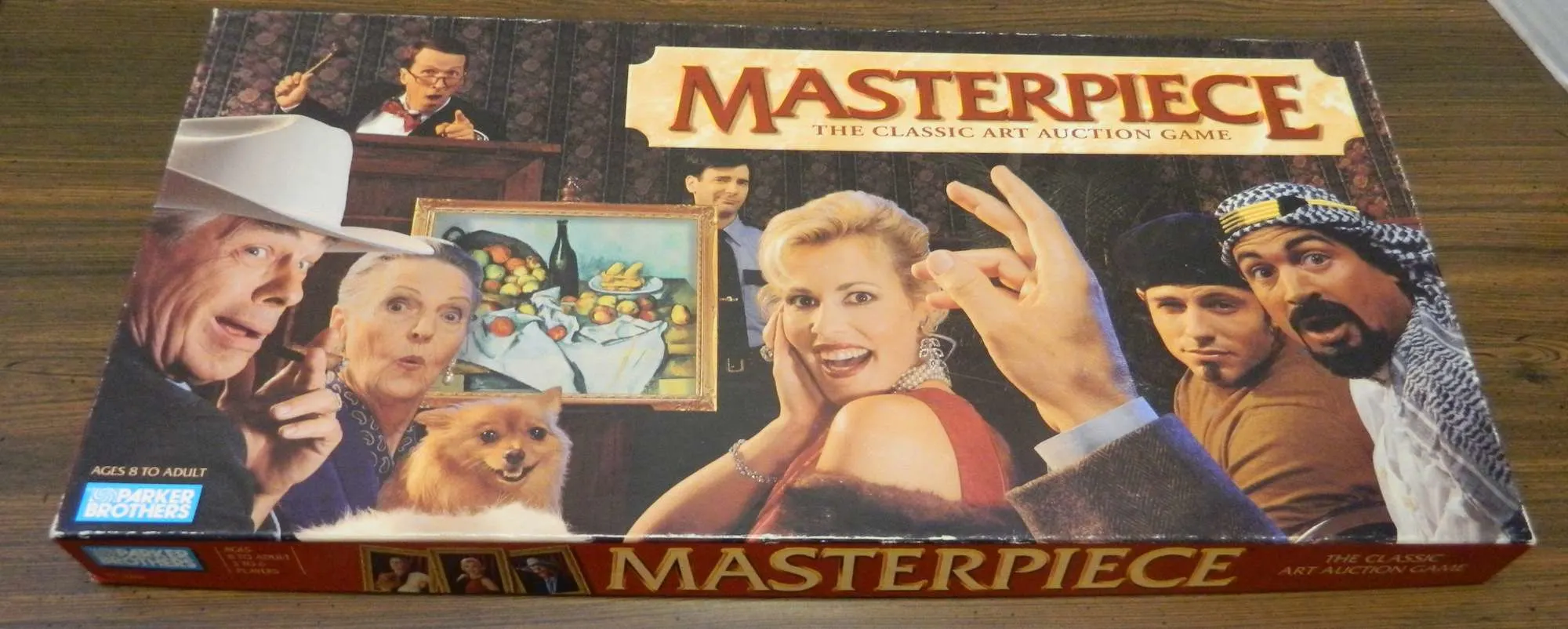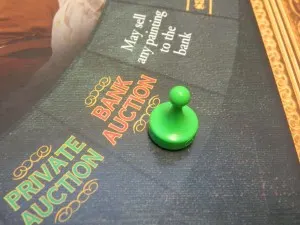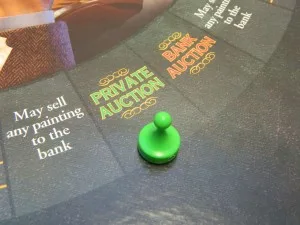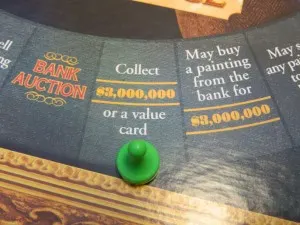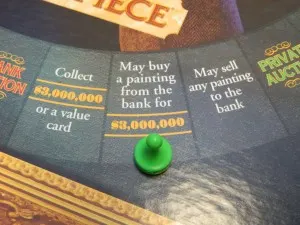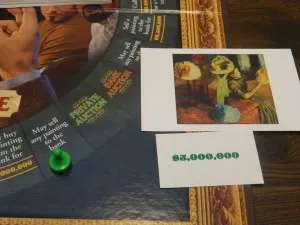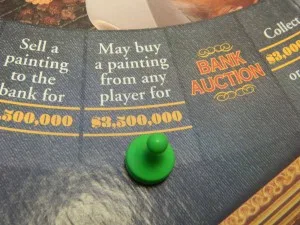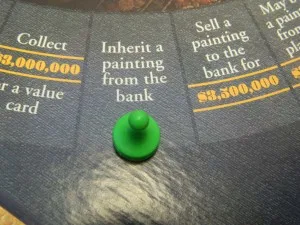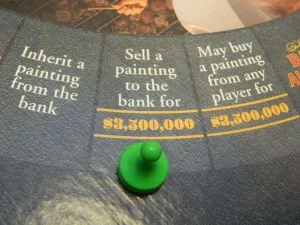How to Play
Objective
By the end of the game create the largest fortune between cash and valuable paintings.
Setup
Each player takes a player piece and places it on any space on the gameboard that they choose (the text on the starting space is ignored). Each player takes a value chart and the remaining value charts are set aside. Each player is given $15 million in play money.
The value cards are shuffled and placed face down on the gameboard. The painting cards are placed next to the value cards and the easel is placed where all of the players can see it. Each player takes a painting card and a value card. The player looks at the value card which tells them how much the painting is worth. The players then put the value card under the painting card.
Players roll the die to determine who gets to play first. Whoever rolls the highest number gets to play first.
Playing the Game
To begin their turn, the player rolls the die and moves around the gameboard clockwise the number of spaces rolled. Players then follow the instructions printed on the space that they landed on.
Bank Auction: Take the top painting and put it on the easel. All of the players then bid on the painting following auction rules. The player that wins the auction pays the bank the corresponding bid, looks at it, and takes the painting along with the top value card which is placed underneath the painting that was bought.
Private Auction: The player that lands on this space has to put up one of their paintings on the auction block if they have one. If the player has multiple paintings, the player to their left gets to pick which painting is put up for auction. All of the players except for the player whose painting is up for sale can bid on the painting. The winning bidder takes the painting and corresponding value card(s) and pays the player whose painting was sold the amount they bid.
Collect $3,000,000 or A Value Card: When a player lands on this space they have a choice on what they want to do. The player can choose to take $3,000,000 from the bank. This option is mandatory if the player has no paintings. The player otherwise can take the top value card and add it to one of their paintings. The player looks at the card and then adds it to any of their paintings. If it has a value on it, that value is added to the paintings current value. If the card is a forgery card it must be put on one of the paintings and will make that painting worthless. Once a value card is added to a painting it must stay with that painting.
May Buy A Painting From the Bank: When a player lands on this space they can buy a painting from the bank for the amount listed on the space. If the player chooses to buy the painting they pay the bank and take the top painting card and value card. If the player chooses not to purchase the painting, the painting goes up for auction where the player that landed on the space cannot bid on the painting.
May Sell Any Painting to the Bank: This space allows a player to sell one of their paintings to the bank for the amount of the value cards underneath the painting. If the painting has a forgery card underneath it, the painting is worth nothing.

One of the value cards underneath this painting is a forgery. This painting is worthless in the game.
If the painting has two or more cards underneath it and none are forgery cards, the painting is worth the value of all of the cards combined.
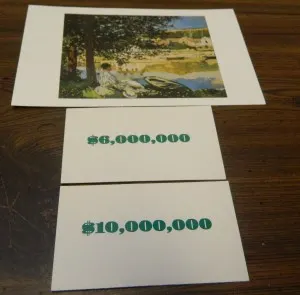
This painting has a $10,000,000 and a $6,000,000 value card attached to it. This painting is worth $16,000,000.
Players are going to want to sell their most valuable painting in order to prevent it from being stolen by one of the other players. The sold painting is removed from the game and the value card is put in the discard pile.
May Buy Any Painting From Any Player For $3,500,000: The player has the option to buy one painting from another player for $3,500,000. The player gets to choose which painting they want. They pay the player and take the painting. The player selling the painting cannot deny the sale.
Inherit A Painting From the Bank: The player landing on the space gets a free painting from the bank along with the top value card.
Sell A Painting to the Bank for $3,500,000: The player landing on the space has to sell one of their paintings to the bank for $3,500,000. Even if the painting is worth more than $3,500,000, the player only receives $3,500,000 from the bank. Players want to sell their lowest valued painting or a forgery in this situation. The sold painting is removed from the game and the value card is put in the discard pile.
Auction Rules
During auctions the following rules must be followed:
- All players bid at the same time. The player who landed on the space that started the auction is the auctioneer and decides who bid first in situations where two players bid at the same time. Except in private auctions, the auctioneer can bid in the auction.
- All opening bids must start at $1,000,000.
- All bids must raise the bid by at least $500,000.
- If any player is caught bidding more on a painting than they actually have in cash, the player is accessed a $1,000,000 penalty which they must pay the bank. If they don’t have a $1,000,000 they lose their next turn.
- If two players bid the same amount at the same time and no one raises the bid, the auction is cancelled with neither player getting the painting.
- You cannot sell paintings unless you land on an appropriate space. You cannot borrow money from the bank or another player.
- If the value cards should run out before the game ends, all of the value cards in the discard pile are shuffled and form a new pile to take value cards from.
Winning the Game
When the last painting has been bought or auctioned off from the bank, the game ends. The players add up their cash and the values of the paintings that they currently own. Whoever has the most value in cash and paintings wins the game.
Review
While not as popular as other Parker Brothers games like Monopoly and Clue, Masterpiece was a pretty successful game for Parker Brothers since the game has had several reprints over three decades. Originally created in 1970 Masterpiece brings you into the world of art dealing as players compete to buy and sell the most valuable paintings while avoiding purchasing forgeries. Despite having an interesting theme and the potential to be a good game, Masterpiece fails due to so much reliance on luck.
Luck will very likely be the reason the eventual winner wins the game. While the game has some decisions (far too few in my opinion), they have little to no actual impact in the game. Masterpiece is one of those games that you play and see who wins since you have little impact on what happens in the game. Luck is so important in the game here is a list of some of the things in the game that rely on luck.
- Landing on the good spaces and avoiding bad spaces.
- Not having to sell any of your paintings in a private auction unless all of your paintings are forgeries or are low values.
- Drawing good value cards for your own paintings.
- Your opponents drawing low value cards.
- Not getting stuck with a forgery.
- Get lucky and get good deals in auctions paying less than the painting is actually worth.
- Inheriting paintings from the bank for free.
- Landing on a space to sell your paintings to the bank at the right time so you can sell them before another player can steal them.
That is probably not even a complete list of all of the areas where luck comes into play. I would be surprised if a game of Masterpiece was ever won without a lot of luck.
This reliance on luck is a shame since the game’s premise is actually quite interesting. The game could have made for an interesting auction game. While the game includes auction elements, they are pretty pointless since every player is pretty much just guessing how valuable a painting is because players have so little information about the value of paintings. There are only two ways a player gets any information about a painting. If they previously owned the painting they will know what it is worth. Players can also somewhat narrow down the possibilities since players know the distributions of the different value cards.
While these two things could give you some information for an educated decision, rarely will they actually help. The same painting will rarely be put up for private auction twice so players won’t be able to bid on a painting they previously owned. While you could do some process of elimination to determine the value possibilities for a painting, you aren’t going to get a good picture from it. There are too many value cards in the game that you won’t see enough of the value cards to be able to make a good conclusion of what values remain in the game.
Since you really can’t figure out how much a painting is worth, you pretty much need to just guess throughout the entire game. Guess well and you will make a lot of money. Guess poorly and you have no chance at winning the game. Always having to guess takes a lot of the satisfaction out of the game. If you do well it is because you guessed well. If you do poorly it is because luck wasn’t on your side. Other than making decisions on playing risky or conservatively your decisions have no impact on the game.
The two elements in the game that I really don’t like are the private auctions and the forgeries.
I don’t like the private auctions because the player auctioning off the painting almost always loses value since the painting rarely sells for as much as it is worth. I don’t think even once in the game that I played that the player who sold a painting in a private auction didn’t lose value. Since there are less bidders in the private auctions it is hard for private auctions to ever go for a lot of money. Unless the private auction is for a worthless or low value painting, you are likely to lose value in a private auction.
My problem with the forgeries is that there are not enough of them in the game. In the 1996 version of the game there are only two forgery cards. This means that only two players or one very unfortunate player will have to deal with forgeries. This puts them at a big disadvantage. I personally think there should have been more forgery cards since it would be more likely to affect all of the players. More forgery cards would have added more risk to the game as well so players would have to play more cautiously.
The components might actually be one of the best parts of Masterpiece. Each version of the game includes 24 different famous paintings. While each version of the game appears to have different paintings, each version includes some well known and some other lesser known paintings. The game should do a good job teaching players about some famous pieces of artwork. Otherwise the components are typical of what you would expect from a Parker Brothers game.
It is a shame that the game relies so much on luck because I think the game could have been good. People who really like art might still enjoy the game despite the game’s flaws because the game does feature some famous works of art and does a decent job simulating an art auction despite the fact that bidders would not bid on painting if they didn’t even know if the painting was real. The art auction theme is a good idea for a game. This was shown to be true by the game Modern Art which was made by Reiner Knizia. While I have never played Modern Art, it has a really good rating on Board Game Geek so I have to assume that it is a good game. Masterpiece is not a terrible game if you don’t mind just playing a game and seeing who wins the game. If you like to have an impact on your fate in the game though, Masterpiece is an average to below average game.
Final Verdict
While I have been kind of harsh on Masterpiece, it is not a terrible game. It just relies way too much on luck to be anything more than a below average to average game. The game is easy to play and you can have some fun with the game but it is frustrating that you have so little impact on what ultimately happens in the game since you are pretty much just guessing throughout the entire game.
If you generally like Parker Brothers games and/or are a big fan of art I think you could enjoy Masterpiece. If luck drives you nuts though you will probably hate Masterpiece.
If you would like to purchase Masterpiece you can purchase it on Amazon. Masterpiece (1970 Edition), Masterpiece (1987 Edition)
, Masterpiece (1996 Edition)

